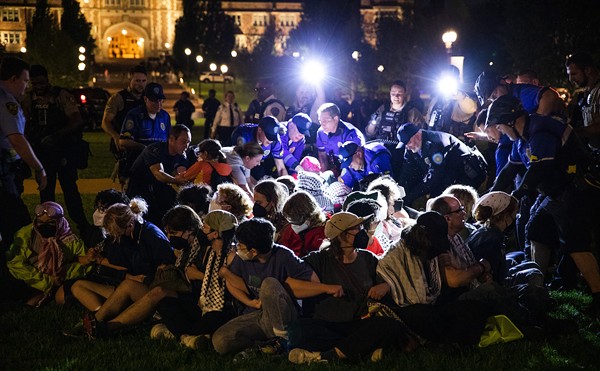Heads, the mayor promised, would roll. He could hardly say otherwise, given the ridiculous ease with which five inmates sauntered out of the St. Louis Medium Security Institution on Feb. 23. Guard towers on the perimeter were empty. There were no surveillance cameras in place. A motion detector on the outside fence didn't work. Security checks by guards were haphazard. Escaping was a simple matter of scraping away mortar and moving aside a few bricks.
The workhouse's response was hardly textbook. Jailers were late in notifying police and couldn't provide officers with identification photos of the fugitives. It didn't help matters that this was the second escape within two weeks. On Feb. 15, a suspected double murderer walked free by swapping identification wristbands with an inmate due to be freed on bail. In that case, jailers waited 30 minutes after discovering the escape before calling police.
Yes, plenty of mistakes made it easy for the mayor to point fingers. On Friday, he announced the suspensions of five corrections employees -- including public-safety director Ed Bushmeyer and corrections commissioner Dora Schriro -- and the firings of the workhouse's chief of security, Michael McKinney, and the building manager, Chuck Cox.
"Our investigation clearly shows this was a management issue," Slay said. "I will not tolerate mediocrity in city government. Everyone knows this just better not happen again."
It's considerably more difficult to accept responsibility for countenancing a corrections system that's been on the brink of disaster for years.
The medium-security workhouse has been stuffed with St. Louis' most dangerous inmates since the city closed its maximum-security jail more than two years ago. What was once a relatively secure repository for murderers, rapists and gun-toting robbers is now a parking lot generating money for the city from Blues fans and other denizens of Savvis Center. The city's new jail under construction across Tucker Boulevard from the courthouse won't be ready for occupancy until this fall. Meanwhile, the city is paying St. Louis County nearly $3 million a year to house prisoners.
The old jail, built in 1914, was far from ideal, but at least it kept inmates where they belonged. More than 130 inmates have fled the workhouse since it opened in 1966, so the recent breakouts shouldn't have been a surprise to Slay or anyone else. Workhouse escapes haven't been the work of masterminds. In November 1999, for instance, an inmate walked out through an unlocked door. He returned after getting hung up on a razor-ribbon fence, then left again through the same door a few minutes later. After scaling the fence, he stole a car and led police on a chase that ended in East St. Louis. Before being captured, he punched a man who refused him a cigarette outside the workhouse and terrorized a woman during a carjacking, hitting her in the face and pushing her out of her moving car. The workhouse discovered the escape after police called and said they had made the arrest.
Heads didn't roll then -- the escape wasn't even mentioned in the Post-Dispatch. Heads didn't roll after six workhouse inmates committed suicide in the space of nine months -- the hangings continued even after an outside consultant found that training, equipment and policies to prevent suicides were sorely lacking [Rushton, "Unlucky Seven," Nov. 7]. Heads didn't roll after a workhouse uprising in December, when inmates briefly took control of a housing unit, nor did Slay talk about firing anyone after the Feb. 15 escape. No one was overly alarmed when guards picketed the workhouse in the summer of 2000, complaining about inadequate training, broken alarms and a lack of staff that compromised security.
"What I find amazing is why now it's a major problem," says JoAnn Williams, business representative for the guards' union, who for years has mailed the mayor and aldermen copies of union-newsletter articles warning about security and staffing problems at the workhouse. "They're not even new situations."
Slay admitted as much in announcing the suspensions and firings. He said he brought in Schriro to fix the workhouse and defended her, noting that she was hired only last fall. Her underlings didn't tell her a tipster had reported that an escape was in the works, said Slay, who pinned the blame on McKinney and Cox for not acting on the tip and informing their superiors. The mayor says Schriro and Bushmeyer still have his confidence. "The system was broken," the mayor said. "Anyone I've talked to out there says it's a management nightmare. You can't fix this in four months."
Curious, then, that the mayor used a shotgun to discipline seven employees, including his designated reformers, when the real culprits were longtime workhouse employees who have learned from experience that the city doesn't take security seriously. The head-chopping and knuckle-rapping rhetoric from Slay may be the best political damage control available, but it also threatens to undercut Schriro's authority with the workhouse troops, who answer to her day in and day out. Without explaining just what Schriro did wrong, the mayor has missed a chance to let her be the one to take strong action and leave no question as to who's in charge at the workhouse.
Providing safe, secure housing for inmates has never been a priority for the city.
The old maximum-security jail was placed under court supervision in 1974 as a result of overcrowding and inhumane conditions, but the city muddled along until it could muddle no more. In early 2000, the city finally closed the jail and sent maximum-security inmates to the workhouse, gambling that a facility that had proved porous would be able to handle the extra prisoners.
Opinions vary on whether the city could have kept the crumbling jail open until the new one is ready.
Williams believes that would have been better than overcrowding the workhouse with inmates it wasn't designed to hold.
Frank Susman, the attorney who represented city inmates in a lawsuit over living conditions in the jail and workhouse, says the old jail was too far gone to remain open.
Former public-safety director Martie Aboussie says it would have been a big risk. The roof leaked, the plumbing often didn't work and the ventilation system was hit-and-miss, but the biggest worry was a bulge in an outside wall. "Was it possible that we could have limped through?" he says. "Possible? Yes. If it wasn't for that bulge in the wall, knowing we were going to build this new jail, I probably would have waited the three or four years." But the city had no backup plan in the event of structural failure.
Judge Timothy J. Wilson has had his fingers crossed since the day the old jail closed. Dangerous criminals such as the ones he sees in his courtroom don't belong in the workhouse, Wilson warns. He also worries about violence at the courthouse. Before the jail closed, the accused were brought directly to court through a tunnel.
"It's not a group of people who mildly misstepped in life -- if you saw a printout of the people being held out there, the crimes they're charged with, it would take your breath away," Wilson says. "There are irate family members of the deceased who would like to get a pop at these guys. The way we do it now, we bring them in a van; we walk them on a public sidewalk and through a public corridor. There have been some things in the hallways, someone running off. We luckily catch them before they get far. But it's just not a safe way to operate.
"I think we're on borrowed time, and we've been doing it for three years now."
Slay was president of the Board of Aldermen when the city announced plans for its new jail back in 1996. At the time, it was supposed to cost $76 million and open in 1999. The old jail would have remained open until the new one opened, eliminating the need to put high-security inmates in the workhouse. Although Slay supported the plan, he either didn't have the political skills needed to push it through the board or didn't consider it a priority. Aldermanic squabbles over the location, design and funding source jacked up the price and delayed the project, which will now cost more than $100 million.
The deal to move inmates to the county lockup cost the city $8,000 more annually than running the old jail, but Slay saw it as money well spent. "I think it is a great idea," Slay told the Post-Dispatch when the agreement was announced. "This allows employees to get trained at a new jail that is similar to our planned jail. I don't see why the Board of Aldermen wouldn't like this."
But there are plenty of reasons to not like the city's deal with the county. By closing the old jail before the new one was ready, the city put itself at the mercy of the county, which could dictate the contract terms. County Executive George "Buzz" Westfall et al took full advantage.
For the county, it's all about the Benjamins, right down to the telephones: The county gets to keep profits from jailhouse collect calls made by city inmates. The city must also provide guards to oversee its inmates -- the county provides little more than laundry service, food and keys to cells. (By contrast, suburban municipalities have all services provided for the same per diem rate paid by the city). More significantly, the county decides which city inmates will do time in Clayton.
The county isn't taking any chances.
The county accepts only minimum- and medium-security inmates from the city, and the county can order problem inmates removed within 24 hours. The county also won't put up with inadequate supervision. Under the contract, the city must provide at least 10 guards and supervisors to oversee a maximum of 256 inmates confined on one floor. On a per-inmate basis, that's a higher staffing level than at the workhouse, where 33 corrections officers guarded nearly 1,100 inmates on the day of the most recent escapes. Furthermore, any guard whom the county doesn't like must be shipped out, ensuring that the city's best and brightest corrections employees are in Clayton, while those who can't pass county muster end up at the workhouse, watching the worst of the worst.
In short, this is regionalism, St. Louis-style.
The fact that escape-prone inmates are in the workhouse when they'd be less of a risk to the public in Clayton doesn't enter into political and economic equations.
The county is collecting more than $2.9 million a year from city taxpayers for jail space. Staffing and other costs push the price tag above $4 million -- far from a bargain, considering that the deal doesn't increase the number of beds for the city's riskiest prisoners. It's not surprising that the county would want to reduce risks, but prisoners don't stop at the city limits when they break out of the workhouse, where a climb over a 12-foot fence is the last step to freedom.
At the county jail, it's a seven-story drop to the ground. No one has escaped from the county hoosegow since it opened in 1998.





